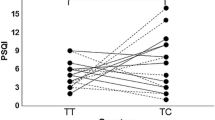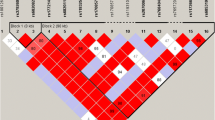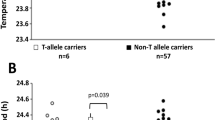Abstract
A possible relationship between human circadian rhythmicity and polymorphisms in clock genes have been documented. However, these data are controversial, and studies both corroborating and denying them have been reported. T3111C Clock polymorphism had been associated with the human evening preference, however, this association has not been confirmed. Moreover, C111G Per2 polymorphism has been associated with the “morning larks” chronotype in one study, not yet replicated. We have, therefore, performed this study to evaluate whether Per2 C111G and Clock T3111C polymorphisms might influence sleep circadian rhythmicity in a sample of 219 Italian volunteers. A possible interaction between these polymorphisms was also investigated. No differences in Per2 C111G and Clock T3111C allele and genotype frequencies were found, and none of the combined Clock T3111C–Per2 C11G genotypes resulted more frequent in one group compared to the others. Present results do not support a role of these polymorphisms in the circadian phenotypes.
Similar content being viewed by others
Avoid common mistakes on your manuscript.
Introduction
The basic functions of sleep are still unclear [1, 2]. In recent years, genetic and molecular studies have became very popular in many fields of science, including those exploring both the physiology and pathology of sleep and its disorders [3]. Furthermore, with the advent of the 24-h society and associated modern lifestyles, the prevalence of sleep disorders appears to be increasing. As the cost of sleep-related problems is considerably high for the Western countries, there is an increasing demand for finding genetic factors in sleep pathology and sleep disorders. However, differently from other fields of medicine, in which single genes have been associated to specific diseases, identifying a gene (or its product) involved in sleep physiology or responsible for sleep disorders is quite a challenge and still far from resolution due to the complexity of sleep structure and of most of the sleep disorders [3].
The sleep-wake cycle is generated through both circadian and homeostatic processes [1, 2]. Circadian rhythmicity is an almost universal property observed in most organisms, including some unicellular organisms. In mammals, the suprachiasmatic nucleus is the main circadian oscillator. “Clock genes” are involved in the maintenance of about 24-h molecular oscillations by the circadian system, and may regulate the sleep-wake cycle. The core of the biological clock (central generator of the circadian rhythm) is thought to consist of interactions of approximately ten clock genes, including Per1/2/3, Cry 1/2, Bmal1, Clock, and casein kinase 1 delta/epsilon (CK1δ/ε) [3]. Until recently, the importance of circadian clock genes in human beings was unclear, although, from rodent and drosophila studies, there was a suspicion that genetic variation in circadian period might explain why some people are “morning larks” while others are “night owls”. In the past 10 years, several groups have documented an association between particular single nucleotide polymorphisms (SNPs) of some of the clock genes and human circadian rhythmicity, even though the results are contrasting and not always conclusive. In particular, the T3111C of the Clock gene (GenBank Accession No. NM_004898) has been associated with “night owls” chronotype by two groups [4, 5]; however, other two groups did not confirm the association [6, 7]. Finally, the C111G of the Per2 gene (rs2304672) has been associated with the “morning larks” chronotype in one study [8], which has not been replicated so far.
In order to provide more insights in this field, we have performed the present study to evaluate whether the Per2 C111G and Clock T3111C SNPs might influence the sleep circadian rhythmicity in healthy Italian population. In addition, a possible interaction between the two polymorphisms has been investigated.
Materials and methods
We analysed a sample of controls with similar geographic origins (Caucasians of clear Italian origin). A total of 219 of unrelated Italian volunteers subjects (105 males and 114 females, age range 22–56) were recruited at our Clinic. To minimize the risk of “genetic contamination”, which could lead to false associations between gene markers and chronotype, we were careful to enrol in the study only controls of clear Italian origin (with at least four generations of Italian-born relatives). The subjects were healthy people, not related to each other and without family history of major sleep disorders. All of them underwent complete blood test, to rule out abnormalities which could have influenced their sleep patterns (i.e. thyroid dysfunction, anemia etc.). Informed written consent for genotype analysis was obtained from each subject, before participation in the study. The study was performed in accordance with the Declaration of Helsinki.
Each volunteer completed the Horne–Ostberg morningness-eveningness (ME) Italian questionnaire (MEQ) [9, 10] to assess the ME preferences. Subjects with sleep disorders were ruled out by a clinical interview, conducted by experts in sleep medicine, which included the Pittsburgh Sleep Quality Index (PSQI) [11] which evaluate nocturnal sleep quality. Epworth Sleepiness Scale (ESS) was administered to each participant to identify and eventually exclude the subjects with excessive daytime sleepiness suggestive of various sleep pathologies. The data were collected throughout 1 year.
Genomic DNA was isolated from the whole blood samples using standard protocols. Genotyping for the Clock T3111C polymorphism was performed with PCR–RFLP technique according to the previously described protocol [5]. Briefly, a 221 bp product was amplified using a set of primers and, therefore, digested overnight with BSP12861 (New England Biolabs, USA). Digestion products were visualized after electrophoresis on a 2% agarose gel containing ethidium bromide. One uncut fragment is observed in the case of wild type 3111T genotype, whereas in the heterozygous samples three fragments can be observed and two in the presence of the 3111CC genotype.
Genotyping for the Per2 C111G polymorphism was performed by direct sequencing, as described [8]. Briefly, a PCR product amplified using a specific set of primers has been directly sequenced in an ABI Prism 310 Genetic Analyzer (Perkin–Elmer Applied Biosystems, Foster City, CA) following standard protocols.
Statistical analysis
The statistical analysis was performed using the SPSS 11.0 statistical package for Windows. To assess the differences in allele distributions, and to verify Hardy–Weinberg equilibrium, we performed the Chi-square (χ2) analysis. The differences in allele and genotype frequencies were analyzed between groups by 2 × 2 contingency tables using χ2 analysis or Fisher’s exact test if one or more variables in 2 × 2 tables were <5. We used 2 × 2 contingency tables to test for interactions between the studied polymorphisms. Data were expressed as means ± SD. Difference in continuous variables between genders was compared by unpaired two-tailed t testing, as well as between genotypes. A P value <0.05 was considered as significant.
Results
From the original population of 219 volunteers, 32 did not return the questionnaires, 10 refused to perform the genetic testing after having completed the questionnaires and having initially given the consent, 12 were eliminated from the study on the basis of blood abnormalities which could have influenced their sleep patterns (e.g. thyroid dysfunction or anemia), and, finally, 9 with ESS total score greater than 10 (suggestive of excessive daytime sleepiness) were excluded from the genetic analysis. Thus, from the original sample, 156 healthy volunteers (104 females and 52 males; mean age 33.1 ± 12.0 years) were analysed for the genetic variants in both Clock and Per2 genes.
The Horne–Ostberg ME Italian questionnaire did not significantly differ between genders (females 50.7 ± 11.0, males 48.6 ± 10.6). Since there was no interaction between gender and the outcome analyzed, both genders have been mixed in the same sample.
Table 1 shows the ME preferences and sleep properties of our population. The majority (51.9%) of the individuals had no sleeping preferences (group I, intermediate), 21.2% were “morning preference” (group M) and 26.9% “evening preference” (group E).
Table 2 shows both allele and genotype frequencies of the studied polymorphisms in the three groups under study. Genotype frequencies conformed to Hardy–Weinberg expectations. We used group I as the reference category and searched for differences in allele frequencies between group M and group I, and between group E and group I, respectively. We also searched for differences in allele frequencies between group E and group M.
Concerning the Clock T3111C polymorphism, the 3111C allele frequencies were 0.26 in group I, 0.25 in group M and 0.22 in group E (Table 2). Allele frequencies were closely similar and the differences were not statistically significant (P = 0.85, group M vs. group I; P = 0.64, group E vs. group I; P = 0.47, group E vs. group M). No significant differences have been observed in the distribution of genotype frequencies between the groups (data not shown).
The frequency of the 111G allele of the Per2 C111G polymorphism was higher in group I (0.12), respect to group M (0.06) and group E (0.04). However, the differences were not statistically significant (P = 0.28, group M vs. group I; P = 0.16, group E vs. group I; P = 1.00, group M vs. group E). No significant differences have been observed in the distribution of the Per2 C111G genotype frequencies between the groups (data not shown).
We also tested for interactions between polymorphisms. None of the combined Clock T3111C–Per2 C111G genotypes resulted more frequent in one group compared to the others (data not shown).
Because of the relatively small size of the groups, and because the Horne–Ostberg ME scale is a continuous variable (where “morning larks” are defined by higher scores, and “night owls” by lower scores), we also compared difference between principal genotypes by unpaired two-tailed t testing. The Horne–Ostberg ME Italian questionnaire did not statistically significantly differ between frequent Clock T3111C genotypes (wild type 48.9 ± 11.1, 3111C heterozygous 49.4 ± 10.5), as well as between frequent Per2 C111G genotypes (wild type 49.0 ± 11.0, 111G heterozygous 50.7 ± 12.9).
Discussion
The circadian clock gives time-context to most physiological processes and behaviours including sleep, and ensures proper entrainment of internal rhythms to the daily light/dark cycle. Therefore, the distribution of sleep over the 24-h day is strongly determined by the circadian process [12]. Many aspects of normal sleep as well as several sleep disorders may have strong genetic components [12]. Mutagenesis has been a successful technique for the identification of genes that regulate circadian rhythms [12, 13]. I.e., in Clock-mutant mice the relative increase in non-REM sleep after sleep deprivation was the same as in wild type mice, although non-REM sleep amount in baseline was reduced [14]. Per2 mutations affected total sleep time, the timing of sleep and the effects of light and dark on sleep patterns in mice [12, 15].
Four previous reports have discussed whether the T3111C Clock polymorphism correlated with ME preferences in humans. Katzenberg and co-workers [4] reported that individuals homo- or hetero-zygous for the 3111C allele had increased evening preference in comparison to subjects with the 3111T/T genotype. Similar results were reached in a Japanese study in 2005 [5]. In contrast, Robilliard and colleagues [6] as well as Pedrazzoli et al. [7] found no association between the 3111C allele and ME preferences in their study populations of 105 and 161 subjects, respectively. In conclusion, it has been suggested that inherited polymorphisms in the Clock gene might influence the human circadian rhythm phenotype preference, but this is still an unresolved question.
The C111G of the Per2 gene has been related to diurnal preference in only one study involving 105 genotyped subjects [8], but has not yet been replicated.
In contrast with some of the previous findings, no association was found between the T3111C Clock and Per2 C11G polymorphisms and ME in our study population. Our study is the first performed in Italy, with a well-characterized genetic population. In our Italian cohort, we could replicate neither the results of Carpen group [8], nor the positive findings reported by Katzenberg [4] and Mishima [5].
The discrepancy in those findings might be in part due to the population selection. 95% of the subjects in the Katzenberg study derived from five different Caucasian ethnic groups (German, British, Scandinavian, Central European, and Southern European), 77.6% in the Pedrazzoli study were Caucasians with no data on the region(s) of origin, whereas information about the ethnic background(s) of the research population in the Robilliard study was not available at all. In the present study, to minimize the risk of genetic contamination, we were careful to enrol only volunteers of certain Italian origin.
Moreover, latitude could be a confounding factor that influences the analysis of studies aimed at exploring the association between “clock genes” variants and circadian phenotypes [16]. Theoretically, the same polymorphism could act differently in different individuals, or population sharing the same genotype, depending on the latitude in which those subjects live.
Although most of the circadian genes that constitute the molecular circadian clock have been discovered via direct molecular techniques and mutagenesis, these genes alone do not explain the complexity of the observed circadian behaviour [12]. However, association studies of “clock genes” have focused on only one gene per time so far [17]. Since these genes codify for proteins that interact with each other, the combination of polymorphisms in different clock genes could have a synergic or inhibitory effect on the circadian phenotypes. We did investigate if an interaction between these two SNPs and circadian phenotype could be responsible for different chronotypes; however, we failed to find any association. Thus, our study seems to exclude a possible relationship between these two SNPs and sleep circadian rhythmicity, at least in Italian healthy population.
We are aware that our study was limited by the relatively small size of the groups enrolled for the present study. Multicenter studies involving large numbers of subjects will be required to more definitively reveal the contribution, if any, of these and other “clock genes” (i.e., PER3 [16]) variants in the diurnal/nocturnal preferences and sleep circadian rhythmicity in humans. Finally, latitude [16] and its interaction with “clock genes” genotypes should be investigated.
References
Borbely AA (1982) A two process model of sleep regulation. Hum Neurobiol 1:195–204
Daan S, Beersma DG, Borbely AA (1984) Timing of human sleep: recovery process gated by a circadian pacemaker. Am J Physiol 246:161–183
Hirayama J, Sassone-Corsi P (2005) Structural and functional features of transcription factors controlling the circadian clock. Curr Opin Genet Dev 15:548–556
Katzenberg D, Young T, Finn L, Lin L, King DP, Takahashi JS, Mignot EA (1998) CLOCK polymorphism associated with human diurnal preference. Sleep 21:569–576
Mishima K, Tozawa T, Satoh K, Saitoh H, Mishima Y (2005) The 3111T/C polymorphism of hClock is associated with evening preference and delayed sleep timing in a Japanese population sample. Am J Med Genet B Neuropsychiatr Genet 133:101–104
Robilliard DL, Archer SN, Arendt J, Lockley SW, Hack LM, English J, Leger D, Smits MG, Williams A, Skene DJ, Von Schantz M (2002) The 3111 Clock gene polymorphism is not associated with sleep and circadian rhythmicity in phenotypically characterized human subjects. J Sleep Res 11:305–312
Pedrazzoli M, Louzada FM, Pereira DS, Benedito-Silva AA, Lopez AR, Martynhak BJ, Korczak AL, Koike Bdel V, Barbosa AA, D’Almeida V, Tufik S (2007) Clock polymorphisms and circadian rhythms phenotypes in a sample of the Brazilian population. Chronobiol Int 24:1–8
Carpen JD, Archer SN, Skene DJ, Smits M, von Schantz M (2005) A single-nucleotide polymorphism in the 5′-untranslated region of the hPER2 gene is associated with diurnal preference. J Sleep Res 14:293–297
Horne JA, Ostberg O (1976) A self-assessment questionnaire to determine morningness–eveningness in human circadian rhythms. Int J Chronobiol 4:97–110
Tonetti L, Fabbri M, Natale V (2008) Sex difference in sleep-time preference and sleep need: a cross-sectional survey among Italian pre-adolescents, adolescents, and adults. Chronobiol Int 25:745–759
Buysse DJ, Reynolds CF III, Monk TH, Berman SR, Kupfer DJ (1989) The Pittsburgh Sleep Quality Index: a new instrument for psychiatric practice and research. Psychiatry Res 28:193–213
O’Hara BF, Ding J, Bernat RL, Franken P (2007) Genomic and proteomic approaches towards an understanding of sleep. CNS Neurol Disord Drug Targets 6:71–81
Vitaterna MH, King DP, Chang AM, Kornhauser JM, Lowrey PL, McDonald JD, Dove WF, Pinto LH, Turek FW, Takahashi JS (1994) Mutagenesis and mapping of a mouse gene, Clock, essential for circadian behavior. Science 264:719–725
Naylor E, Bergmann BM, Krauski K, Zee PC, Takahashi JS, Vitaterna MH, Turek FW (2000) The circadian clock mutation alters sleep homeostasis in the mouse. J Neurosci 20:8138–8143
Shiromani PJ, Xu M, Winston EM, Shiromani SN, Gerashchenko D, Weaver DR (2004) Sleep rhythmicity and homeostasis in mice with targeted disruption of mPeriod genes. Am J Physiol Regul Integr Comp Physiol 287:R47–R57
Pereira DS, Tufik S, Louzada FM, Benedito-Silva AA, Lopez AR, Lemos NA (2005) Association of the length polymorphism in the human Per3 gene with the delayed sleep-phase syndrome: does latitude have an influence upon it? Sleep 28:29–32
Ciarleglio CM, Ryckman KK, Servick SV, Hida A, Robbins S, Wells N, Hicks J, Larson SA, Wiedermann JP, Carver K, Hamilton N, Kidd KK, Kidd JR, Smith JR, Friedlaender J, McMahon DG, Williams SM, Summar ML, Johnson CH (2008) Genetic differences in human circadian clock genes among worldwide populations. J Biol Rhythms 23:330–340
Acknowledgments
This work was performed in the frame of AMBISEN Center, High Technology Center for the study of the Environmental Damage of Endocrine and Nervous System, University of Pisa.
Author information
Authors and Affiliations
Corresponding author
Rights and permissions
About this article
Cite this article
Choub, A., Mancuso, M., Coppedè, F. et al. Clock T3111C and Per2 C111G SNPs do not influence circadian rhythmicity in healthy Italian population. Neurol Sci 32, 89–93 (2011). https://doi.org/10.1007/s10072-010-0415-1
Received:
Accepted:
Published:
Issue Date:
DOI: https://doi.org/10.1007/s10072-010-0415-1




